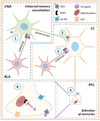Drug discovery strategies that focus on the endocannabinoid signaling system in psychiatric disease
- PMID: 25488672
- PMCID: PMC4696509
- DOI: 10.1517/17460441.2014.966680
Drug discovery strategies that focus on the endocannabinoid signaling system in psychiatric disease
Abstract
Introduction: The endocannabinoid (eCB) system plays an important role in the control of mood, and its dysregulation has been implicated in several psychiatric disorders. Targeting the eCB system appears to represent an attractive and novel approach to the treatment of depression and other mood disorders. However, several failed clinical trials have diminished enthusiasm for the continued development of eCB-targeted therapeutics for psychiatric disorders, despite the encouraging preclinical data and promising preliminary results obtained with the synthetic cannabinoid nabilone for treating post-traumatic stress disorder.
Areas covered: This review describes the eCB system's role in modulating cell signaling within the brain. There is a specific focus on eCB's regulation of monoamine neurotransmission and the stress axis, as well as how dysfunction of this interaction can contribute to the development of psychiatric disorders. Additionally, the review provides discussion on compounds and drugs that target this system and might prove to be successful for the treatment of mood-related psychiatric disorders.
Expert opinion: The discovery of increasingly selective modulators of CB receptors should enable the identification of optimal therapeutic strategies. It should also maximize the likelihood of developing safe and effective treatments for debilitating psychiatric disorders.
Keywords: CB1 receptors; anxiety; clinical trials; depression; hypothalamic–pituitary–adrenal axis; monoamines; post-traumatic stress disorder; stress response.
Conflict of interest statement
The authors have no other relevant affiliations or financial involvement with any organization or entity with a financial interest in or financial conflict with the subject matter or materials discussed in the manuscript apart from those disclosed.
Figures

Similar articles
-
The endocannabinoid system and psychiatric disorders.Exp Neurol. 2010 Jul;224(1):3-14. doi: 10.1016/j.expneurol.2010.03.018. Epub 2010 Mar 29. Exp Neurol. 2010. PMID: 20353783 Review.
-
Cannabinoids as therapeutics for PTSD.Pharmacol Ther. 2020 Jul;211:107551. doi: 10.1016/j.pharmthera.2020.107551. Epub 2020 Apr 18. Pharmacol Ther. 2020. PMID: 32311373 Review.
-
Don't Worry, Be Happy: Endocannabinoids and Cannabis at the Intersection of Stress and Reward.Annu Rev Pharmacol Toxicol. 2017 Jan 6;57:285-308. doi: 10.1146/annurev-pharmtox-010716-104615. Epub 2016 Sep 2. Annu Rev Pharmacol Toxicol. 2017. PMID: 27618739 Review.
-
Integration of endocannabinoid signaling into the neural network regulating stress-induced activation of the hypothalamic-pituitary-adrenal axis.Curr Top Behav Neurosci. 2009;1:289-306. doi: 10.1007/978-3-540-88955-7_12. Curr Top Behav Neurosci. 2009. PMID: 21104389 Review.
-
The endocannabinoid system in mental disorders: Evidence from human brain studies.Biochem Pharmacol. 2018 Nov;157:97-107. doi: 10.1016/j.bcp.2018.07.009. Epub 2018 Jul 17. Biochem Pharmacol. 2018. PMID: 30026022 Review.
Cited by
-
Pregnenolone blocks cannabinoid-induced acute psychotic-like states in mice.Mol Psychiatry. 2017 Nov;22(11):1594-1603. doi: 10.1038/mp.2017.4. Epub 2017 Feb 21. Mol Psychiatry. 2017. PMID: 28220044 Free PMC article.
-
Endocannabinoid Receptors in the CNS: Potential Drug Targets for the Prevention and Treatment of Neurologic and Psychiatric Disorders.Curr Neuropharmacol. 2020;18(8):769-787. doi: 10.2174/1570159X18666200217140255. Curr Neuropharmacol. 2020. PMID: 32065105 Free PMC article. Review.
-
Acute cortisol reactivity attenuates engagement of fronto-parietal and striatal regions during emotion processing in negative mood disorders.Psychoneuroendocrinology. 2016 Nov;73:67-78. doi: 10.1016/j.psyneuen.2016.07.215. Epub 2016 Jul 22. Psychoneuroendocrinology. 2016. PMID: 27474908 Free PMC article.
-
Cortical adrenoceptor expression, function and adaptation under conditions of cannabinoid receptor deletion.Exp Neurol. 2017 Jun;292:179-192. doi: 10.1016/j.expneurol.2017.03.010. Epub 2017 Mar 21. Exp Neurol. 2017. PMID: 28341460 Free PMC article.
-
Prefrontal endocannabinoids, stress controllability and resilience: A hypothesis.Prog Neuropsychopharmacol Biol Psychiatry. 2018 Jul 13;85:180-188. doi: 10.1016/j.pnpbp.2017.04.004. Epub 2017 Apr 7. Prog Neuropsychopharmacol Biol Psychiatry. 2018. PMID: 28392485 Free PMC article. Review.
References
-
- Green B, Kavanagh D, Young R. Being stoned: a review of self-reported cannabis effects. Drug and Alcohol Review. 2003;22:453–460. - PubMed
-
- Velez CN, Johnson J, Cohen PA. A longitudinal analysis of selected risk factors for childhood psychopathology. Journal of the American Academy of Child and Adolescent Psychiatry. 1989;28:861–864. - PubMed
-
- Di Marzo V, Bifulco M, De Petrocellis L. The endocannabinoid system and its therapeutic exploitation. Nature Reviews Drug Discovery. 2004;3:771–784. - PubMed
-
- Reilly D, Didcott P, Swift W, et al. Long-term cannabis use: characteristics of users in an Australian rural area. Addiction. 1998;93:837–846. - PubMed
-
- Lee KS, Conigrave KM, Patton GC, et al. Cannabis use in remote Indigenous communities in Australia: endemic yet neglected. Medical Journal of Australia. 2009;190:228–229. - PubMed
Publication types
MeSH terms
Substances
Grants and funding
LinkOut - more resources
Full Text Sources
Other Literature Sources
Medical
Molecular Biology Databases
